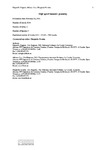High speed turnouts’ geometry

Use this link to cite
http://hdl.handle.net/2183/32308
Except where otherwise noted, this item's license is described as Atribución-NoComercial-SinDerivadas 3.0 España
Collections
- Investigación (ETSECCP) [826]
Metadata
Show full item recordTitle
High speed turnouts’ geometryAlternative Title(s)
Geometry of High-Speed TurnoutsDate
2011Citation
Bugarín, M. R., Orro, A., Novales, M. (2011). [Manuscrito aceptado] High speed turnouts’ geometry. Transportation Research Record, 2261(1), 64–72. https://doi.org/10.3141/2261-08
Abstract
[Abstract:] Turnouts are singular points of the railway track. A series of advances have been added to their design in the last
20 years, in the same way as the other elements that constitute the track structure. These developments have
allowed the vehicles to increase their running speed over the turnouts, as well as to improve their reliability and
security, reducing, in this way, maintenance costs.
This paper is focused in geometric improvements adopted in turnouts in order to get high speeds over
direct (350 km/h) and diverging (160 – 220 km/h) tracks. These improvements are related to diverging track
alignments introducing transition curves, switch rail design and mechanization in order to avoid the straight
switch rail strike phenomenon, as well as to crossing modifications so as to avoid the existence of the gap.
Keywords
Turnouts
Railway track
Track structure
Reliability
Security
High speed
Direct tracks
Diverging tracks
Railway track
Track structure
Reliability
Security
High speed
Direct tracks
Diverging tracks
Description
Manuscrito aceptado para publicación (postprint) en: Bugarín, M. R., Orro, A., Novales, M. (2011). Geometry of High-Speed Turnouts. Transportation Research Record, 2261(1), 64–72. https://doi.org/10.3141/2261-08
Editor version
Rights
Atribución-NoComercial-SinDerivadas 3.0 España






